Island Stories:
![]() Danzig
Mine
Danzig
Mine
![]() Zeballos
Iron Mine
Zeballos
Iron Mine
![]() Conuma
Peak 1910
Conuma
Peak 1910
Alexandra Peak
Argus Mountain
Bate/Alava Sanctuary
Beaufort Range
Big Interior Mtn
Big Interior Mtn 1913
Part 1
Part 2
Bolton Expedition 1896
Cliffe Glacier
Clinton Wood
Comox Glacier
Comox Glacier 1922
Comox Glacier 1925
Comstock Mtn
Conuma Peak
Copper King Mine
Crown Mtn
Elkhorn 1912
Elkhorn 1949
Elkhorn 1968
Eugene Croteau
Golden Bullets
Golden Hinde 1913/14
Golden Hinde 1937
Golden Hinde 1983
Harry Winstone Tragedy
Jack Mitchell
Jim Mitchell Tragedy
John Buttle
Judges Route
Koksilah's Silver Mine
Landslide Lake
Mackenzie Range
Malaspina Peak
Mariner Mtn
Marjories Load
Matchlee Mountain
Mount McQuillan
Mt. Albert Edward
Mt. Albert Edward 1927
Mt. Albert Edward 1938
Mt. Becher
Mt. Benson 1913
Mt. Benson
Mt. Doogie Dowler
Mt. Colonel Foster
Mt. Hayes/Thistle Claim
Mt. Maxwell
Mt. Sicker
Mt. Tzouhalem
Mt. Whymper
Muqin/Brooks Peninsula
Nine Peaks
Queneesh
Ralph Rosseau 1947
Rosseau Chalet
Ralph Rosseau Tragedy
Rambler Peak
Red Pillar
Rex Gibson Tragedy
Sid's Cabin
Steamboat Mtn
Strathcona Park 1980's
The Misthorns
The Unwild Side
Victoria Peak
Waterloo Mountain 1865
Wheaton Hut/Marble Meadows
William DeVoe
Woss Lake
You Creek Mine
Zeballos Peak
Other Stories:
Sierra
de los Tuxtlas
Antarctica
Cerro del Tepozteco
Citlaltepetl
Huascaran
Mt. Roraima
Nevada Alpamayo
Nevada del Tolima
Nevado de Toluca
Pico Bolivar
Popocatepetl
Uluru/Ayers Rock
Volcan Purace
Volcan San Jose
Biographies
Island 6000
Cartoons
Order the Book
Contact Me
Links

Conuma
Peak:
The Matterhorn of Nootka Sound
by Lindsay Elms
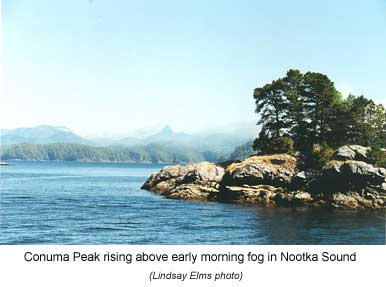 When
one hears the name Matterhorn one is instantly reminded of the picturesque
mountain located on the border of Italy and Switzerland. Towering above
the town of Zermatt it is one of the most photographed mountains in the
world. It is a name that has become synonymous with any sharp and striking
peak. The Canadian Rockies has Mount Assiniboine, often called the Matterhorn
of the Rockies, and in Strathcona Provincial Park on Vancouver Island
there is Elkhorn
which was first called the Strathcona Matterhorn. However, historical
Nootka Sound on the west coast also has its own beautiful Matterhorn.
When
one hears the name Matterhorn one is instantly reminded of the picturesque
mountain located on the border of Italy and Switzerland. Towering above
the town of Zermatt it is one of the most photographed mountains in the
world. It is a name that has become synonymous with any sharp and striking
peak. The Canadian Rockies has Mount Assiniboine, often called the Matterhorn
of the Rockies, and in Strathcona Provincial Park on Vancouver Island
there is Elkhorn
which was first called the Strathcona Matterhorn. However, historical
Nootka Sound on the west coast also has its own beautiful Matterhorn.
Located at the head of the Tlupana Inlet between Gold River and Tahsis is the Nootka Matterhorn. A high craggy spire of rock that is a conspicuous navigational feature in Nootka Sound for all types of boats: from the old wooden sailing vessels of the early navigators to the high-tec aluminum sport fishing boats to recreational sea-kayaks. This peak has been known by its native name since time immemorial as Conuma Peak. Conuma (or Konoomah) means high or rocky peak. On a chart drawn by the Spanish Navy Commander Dionisio Galiano in 1792 the mountain was called Pico de Tasis, evidently after the native chief Maquinna's principal village at the head of the nearby Tahsis Inlet, but he later changed it back to its original name.
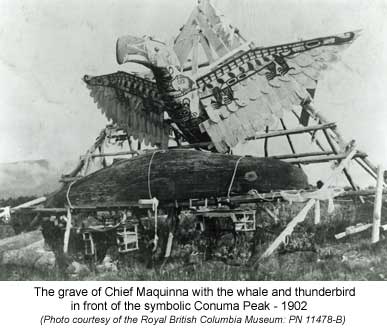 This
peak is also significant to the west coast First Nation's People. Mowachaht
whale hunters went to Conuma Peak for spiritual purification and guidance.
In Galiano's journal he wrote the following about Conuma: "The corpses
of the chiefs are borne up in pomp by common people, with continuous lamentation
to the slopes or brow of the very high mountain …" An old archival
photograph taken around 1902 shows a picture of the mythical Thunderbird
with a Whale beneath a wooden symbolic structure representing Conuma Peak
at the grave of the hereditary chief Maquinna. Obviously the mountain
took on a sacred meaning in the spiritual afterlife of the natives.
This
peak is also significant to the west coast First Nation's People. Mowachaht
whale hunters went to Conuma Peak for spiritual purification and guidance.
In Galiano's journal he wrote the following about Conuma: "The corpses
of the chiefs are borne up in pomp by common people, with continuous lamentation
to the slopes or brow of the very high mountain …" An old archival
photograph taken around 1902 shows a picture of the mythical Thunderbird
with a Whale beneath a wooden symbolic structure representing Conuma Peak
at the grave of the hereditary chief Maquinna. Obviously the mountain
took on a sacred meaning in the spiritual afterlife of the natives.
Captain James Cook was the first European to see the Nootka Matterhorn when he sailed into the Indian village of Yuquot (Friendly Cove) on March 29, 1778 with his two vessels the Discovery and Resolution. Cook named the area King George's Sound after the reigning British monarch, however, later he changed it to Nootka Sound. Cook had learned this name from the local Indians when he tried to find out from them what the area was known as. As he waved his arms around in a sweeping circle they said "Nootka" and he took this to be their name of the surrounding area.
In Cook's daily journal he wrote: "…the inland mountains were covered in snow, in other respects they seemed naked." The Nootka Matterhorn would have been the tallest peak that he could see of those inland mountains, but at the time it was of little consequence to him as he had seen numerous high snowy mountains on his journey up the west coast of the continent. Cook's attention would have been directed more towards safe passage through unknown waters and maintaining a cautious contact with the natives of this new land. As for climbing, it was another seventy-five years before the "Golden Age" of alpinism marked the start of modern mountaineering as a sport. Cook spent one month refitting his two vessels before sailing back out into the Pacific, but the way was paved for further exploration.
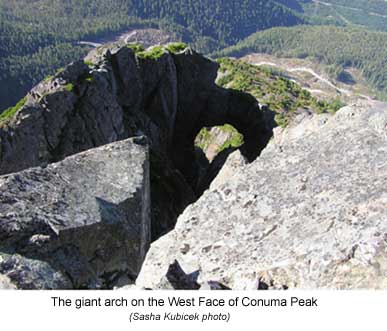 Nootka
Sound experienced a flurry of activity after Cook's visit as both the
British and Spanish began vying for territorial supremacy over the new
land. The Spanish believed they could claim sovereignty over Nootka by
rights of divine law due to discovery by Captain Juan Perez in 1774 when
he anchored overnight off Estevan Point just south of Nootka Sound. The
British argued that discovery alone didn't give the right to ownership.
They stated that the land had to be occupied and developed. Cook's month
long stay and Captain John Meares' subsequent claim of having 'purchased'
land from Chief Maquinna in 1788, were used as evidence of Britain's long
term interest in the area. After the two countries almost came to war,
the conflict was resolved by the Nootka Convention when both parties signed
an agreement to the mutual abandonment of Nootka in 1794. For the Spanish
this signalled the end of their hopes for territorial gains in Pacific
Northwest and in 1819 the Spanish retreated altogether.
Nootka
Sound experienced a flurry of activity after Cook's visit as both the
British and Spanish began vying for territorial supremacy over the new
land. The Spanish believed they could claim sovereignty over Nootka by
rights of divine law due to discovery by Captain Juan Perez in 1774 when
he anchored overnight off Estevan Point just south of Nootka Sound. The
British argued that discovery alone didn't give the right to ownership.
They stated that the land had to be occupied and developed. Cook's month
long stay and Captain John Meares' subsequent claim of having 'purchased'
land from Chief Maquinna in 1788, were used as evidence of Britain's long
term interest in the area. After the two countries almost came to war,
the conflict was resolved by the Nootka Convention when both parties signed
an agreement to the mutual abandonment of Nootka in 1794. For the Spanish
this signalled the end of their hopes for territorial gains in Pacific
Northwest and in 1819 the Spanish retreated altogether.
The final division of the Pacific Northwest occurred in 1846 under the Oregon Boundary Treaty. This treaty between the United States and Britain, extended the international boundary along the 49th parallel and through the Juan de Fuca Straits to the Pacific Ocean. Regions to the north of that line became British territory.
Nootka Sound began seeing renewed activity as the Hudson's Bay Company moved out to the west coast. Both the fur trade and fishing industries boomed with canneries springing up in sheltered coves on the coast. By the early 1900's the number of ships on the west coast had increased dramatically. Because of the rugged nature of Vancouver Island there were no roads across it to transport goods so the big ships were required to travel the dangerous west coast route.
With the increase in boats on the west coast there was also an increase in shipping accidents and the coast became strewn with shipwrecks. Coastal charts were vague and not all the hidden reefs were located. Although hydrographic surveys had taken place in the late 1800's, a more accurate survey of the coast and water depths was required.
In the 1930's when survey techniques had been refined two ships, the William J. Stewart and the Pender, were called in to undertake a hydrographic survey of the west coast. The two vessels moved up the coast anchoring for periods while the surveyors and crew took depth soundings of the inlets and made accurate survey readings of the coastline. In the summer of 1933 the Pender was towed into Plumper Harbour on the inside of Nootka Island to seek a sheltered anchorage. From here Conuma Peak dominated the eastern horizon. It was decided that a survey station should be erected on the mountain's summit because it could be seen many miles at sea. The lower mountains were usually shrouded in fog during the summer months.
Although none of the Pender's crew were mountaineers, three men were chosen to assist Andy Morod in establishing the survey station on Conuma's summit. Andy Morod was a small wiry Swiss immigrant who had spent the winter at Muchalet Lake trapping beaver. He had just hiked and canoed out with his year's catch to the Pender and because of his mountaineering background was asked to lead the climb.
At that time no trail existed up the valley so one had to be blazed to the base of the mountain. The men carried heavy packs as they needed to carry not only four days worth of food, but ropes for pulling up poles and a mast to the top, as well as nails, spikes and enough calico material to make the flag and wrap the upper portion of the station.
After four days the men return triumphant having built their station on the summit but it was not without complaint. The Pender's crew were not accustomed to such strenuous work and found the hardships trying. Morod was familiar with the hardships involved with being in the mountains, but by the end of the four days he too was happy to return to the relative luxury of the ship. The biggest problem they experienced was the lack of drinking water as they had not been issued canvas water containers for the trip.
The station proved satisfactory and survey readings were taken by the crew of the William J. Stewart many miles out to sea. Their charts have helped minimize the danger of navigating in the rough waters and saved many boats from a perilous end on the reefs and rugged coastline.
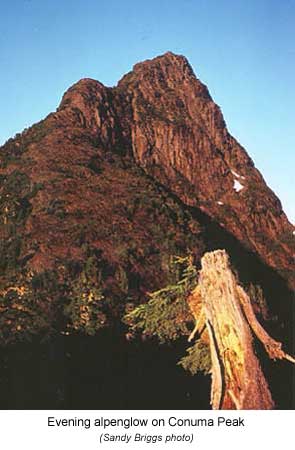 However,
surveyors used the mountain's summit not only for mapping the coastline.
During 1946 to 1948, Alfred
Slocomb was involved in the topographical survey of
the West Coast of Vancouver Island. He was completing the Map sheets 92
E/9. 92 E/10, and 92 E/16 of the national topographical 1:50,000 series
filling in the gap between Alan
Campbell's area of 1932 to the north, and Norman
Stewart's 1937 area to the east, and the Dominion Zeballos
sheet to the west.
However,
surveyors used the mountain's summit not only for mapping the coastline.
During 1946 to 1948, Alfred
Slocomb was involved in the topographical survey of
the West Coast of Vancouver Island. He was completing the Map sheets 92
E/9. 92 E/10, and 92 E/16 of the national topographical 1:50,000 series
filling in the gap between Alan
Campbell's area of 1932 to the north, and Norman
Stewart's 1937 area to the east, and the Dominion Zeballos
sheet to the west.
Conuma Peak lies approximately in the center of the Map sheet 92 E/16 and twice during the 1947 season Slocomb ascended to the summit to take triangulation readings. These maps are still in use today, however, periodically they are updated to accommodate changes in the physical features.
In the next forty years it is unknown how often Conuma Peak was climbed, but it is likely that locals from the area who saw the mountain almost every day would have been tempted to climb the peak. However, the next recorded ascent was not until the late 1980's.
John Gibson, from Duncan, had first seen the mountain in 1952 while visiting Nootka Sound and he thought the mountain looked more impressive than its altitude of 1,481 metres might suggest. It wasn't until both he and Syd Watts returned from a climbing trip up island years later that they decided to give it a try.
On Saturday August 27, 1989 they drove up to the area in Gibson's old Landrover and camped beside a spur road off H-60 which crossed an unnamed creek (a tributary of the Tlupana River.) The next morning they left camp at 8:30 A.M. and ascended the steep bush, working their way around rock bluffs until they arrived on the Southwest Ridge.
Ahead of them loomed the final three hundred metres of the summit pyramid. They continued climbing up the narrowing ridge to a point where they arrived at a gap between a rock pinnacle and the main ridge. With steep cliffs on both sides they were fortunate to find the wall dissected by a V-shaped groove which gave access to a short chimney with a convenient tree near the top. The rope was pulled out from their pack and the tree was used as a belay anchor on the exposed pitch. From there it was an easy scramble to the summit.
They found the summit to be a magnificent viewpoint! To the southwest they looked out over a blanket of sea fog that hid Nootka Sound where they thought the hills looked like islands in the white ocean. In all the other directions they were looking out over the mountains of Vancouver Island that they had become familiar with through years of climbing and exploring.
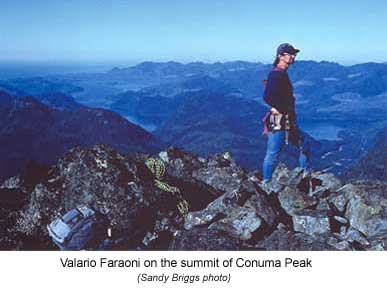 Only
a short time was spent on the summit before they had to descend. From
where they were they could look down onto a broad alpine plateau with
little pools about three hundred metres below them to the northeast. It
also looked as though they might find a route back to the valley floor
that was less bushy and less steep then the way they came up. Uncertain
of the first one hundred seventy metres, they gingerly worked their way
down toward the plateau knowing that their way could be blocked at any
point by hidden drop-offs. Fortunately, they encountered only one seven-metre
bluff that they needed to rappel. Once on the plateau they stopped for
a swim in one of the mountain tarns and a rest before going on down through
the forest to their vehicle which they reached at 6:30 P.M..
Only
a short time was spent on the summit before they had to descend. From
where they were they could look down onto a broad alpine plateau with
little pools about three hundred metres below them to the northeast. It
also looked as though they might find a route back to the valley floor
that was less bushy and less steep then the way they came up. Uncertain
of the first one hundred seventy metres, they gingerly worked their way
down toward the plateau knowing that their way could be blocked at any
point by hidden drop-offs. Fortunately, they encountered only one seven-metre
bluff that they needed to rappel. Once on the plateau they stopped for
a swim in one of the mountain tarns and a rest before going on down through
the forest to their vehicle which they reached at 6:30 P.M..
Today mountaineers are able to access Conuma Peak from logging roads that reach high up into the surrounding valleys. Although not a popularly sought after peak to climb, for the mountaineer seeking an exciting adventure, the Nootka Matterhorn, offers a unique west coast challenge that culminates with incredible views of historical Nootka Sound.
How to order | | About the Author || Links || Home
Contact:
Copyright ©
Lindsay Elms 2001. All Rights Reserved.
URL: http://www.beyondnootka.com
http://www.lindsayelms.ca